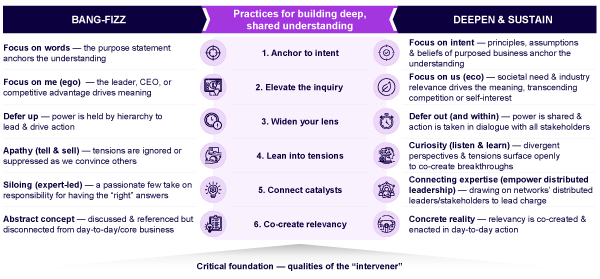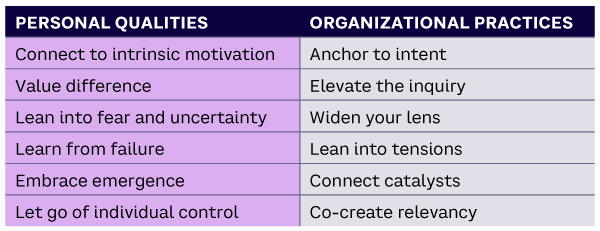AMPLIFY VOL. 37, NO. 8

This is the way the world ends. Not with a bang but a whimper.
— T.S. Eliot, The Hollow Men
Commitment to purpose-led business is growing; so, too, is skepticism of the intent and efficacy of organizations to transform their business models to profitably serve people and the planet. Part of this critique is the perceived nebulousness around what “purpose-driven” means in practice — particularly in challenging contexts.
Those who are committed to transitioning business ecosystems toward greater health are torn between feeling a need to create (and perhaps impose) more clarity to preserve the legitimacy of the movement and the recognition that this change might necessitate a more nuanced, evolving approach, anchored in a shared understanding of what it means to be a purpose-driven business.
Without this shared understanding, we often see purpose being introduced into an organization with an initial “bang” that promises to provide much-needed direction for the business and bring a sense of meaning to the stakeholders involved but “fizzles” away quietly as the organization returns to business as usual (traditional, profit-centric practices).1
In the modern landscape, being purpose-driven is no longer a peripheral concept but is recognized as a critical driver of organizational success. The challenge for business leaders and purpose practitioners is clear: ensure your purpose doesn’t end with a whimper but rather invigorates and propels your organization forward. This article draws on the findings of the Purpose-in-Practice Community, which explores more favorable conditions for transformative change and a lasting impact.2
The Bang-Fizz Dilemma
The bang-fizz dilemma describes a common trajectory observed by our community when their organizations attempt to embed purpose. The bang is an enthusiastic launch of purpose characterized by high energy, grand statements, and ambitious plans. This phase often involves leaders passionately advocating for the new direction, employees showing high levels of engagement, and stakeholders expressing optimism about the future. In time, the initial enthusiasm fizzles out. This phase is marked by waning interest, decreased engagement, and a gradual return to conventional practices focused on short-term gains.
A reason for the bang-fizz is a lack of a deeply embedded, shared understanding of what it means to be purpose-driven. Without this foundation, purpose remains a superficial or theoretical concept, easily overshadowed by short-term goals and operational pressures.
The community’s inquiries focus on the practices and approaches of creating a shared understanding, rather than an exploration of the definition of purpose-driven business (such definitions and frameworks already exist). We need more effective approaches to creating and sustaining a shared understanding and commitment to purpose across an organization (and beyond). Leaders and practitioners must also develop their capacity to meet resistance and navigate challenges — shifting the emphasis from “what” to “how.”
Skepticism grows as people within organizations become tentative toward (or unknowingly ignore) the presence of purpose-driven efforts within the business. The fizz can be attributed to several factors:
-
Superficial commitment. Initial commitment to purpose is often superficial, driven by external pressures rather than genuine internal motivation. Organizations may adopt purpose-driven rhetoric to align with market trends or appease stakeholders, without fully integrating it into their core operations.
-
Lack of sustained effort. Maintaining a purpose-driven approach requires continuous effort, resources, and dedication. Many organizations underestimate the level of commitment needed to sustain purpose over the long term.
-
Misalignment of purpose and strategy. Purpose must be seamlessly integrated into an organization’s strategy, operations, and culture. Misalignment between purpose and business practices leads to disillusionment and disengagement among employees.
-
Insufficient stakeholder engagement. For purpose to thrive, it must resonate with all stakeholders, including employees, customers, suppliers, and the broader community. Inadequate stakeholder engagement undermines the collective commitment to purpose.
How to Cultivate Purpose
One should consider the opposite end of the spectrum: how your work deepens and sustains and how developing shared understanding requires you to move toward that rather than simply avoiding the fizz. By acknowledging and understanding the nature of the bang-fizz phenomenon, one can reflect on the behaviors that prevent purpose from having a meaningful effect on organizations.
Figure 1 illustrates how companies that deliberately cultivate the conditions on the right of the diagram could be better positioned to deepen and sustain a shared understanding of purpose over time. The conditions illustrated on the left — though some are necessary to create the energy and mandate for purpose (e.g., leadership commitment, passionate experts, well-articulated purpose statements) — are not sufficient to sustain it in the long term and contribute to the bang-fizz phenomenon.

Through this lens, the necessary shifts in behaviors and approaches to work are visible. Raising the level of understanding and commitment to purpose in an organization is a continuous endeavor. It’s complex, adaptive, and typically asks us to work at a level that is deeper and more personally meaningful and challenging than habitual ways of working.
The cumulative effect of falling into two or more of the habitual traps on the left side can create a perfect storm where purpose, once thought to be a bright guiding star, loses its shine. Accepting the need to find new ways to avoid the fizz and deepen and sustain efforts (ways that cut across hierarchy and the “normal way things are done around here”), the model explores more favorable conditions for more effective and lasting change.
Move from Focusing on Words to Focusing on Intent
“Finally! We have arrived at the perfectly crafted purpose statement that describes our reason for being. Now let’s tell people, plaster it on the walls, shout it from the pulpit!”
Sound familiar? The purpose statement and narrative are hugely important. But, for most businesses to transform into a force for good, a statement of words and communications is insufficient. Without exploring and discussing the intent and deep shifts in underlying beliefs and assumptions about how an organization creates value for its stakeholders and society, the purpose statement will be ineffectual.
Limiting assumptions and tacit beliefs that hold a powerful grip on individuals restrict what is viewed as possible to change. For many businesses, the intent to become purpose-driven is a fundamental shift in the beliefs and assumptions that underpin how an organization creates value for all its stakeholders and society. This often goes unacknowledged.
Focusing on intent invites us to leverage the power of generative dialogue and collective sensemaking. Why? Because orienting toward the needs of people and the planet is not a task or communication challenge — it’s a value system, a way of being. For action to be authentic and sustained, the intent must be meaningful. How you make meaning is a personal process — one that happens in relationship to past and current experiences and to others.
Move from Focusing on Me to Focusing on Us
A business might have a visionary CEO who is passionate about being purpose-driven. But one person’s passion can inadvertently stop others from developing their own desires, beliefs, and commitments. This risks purpose compliance: people going along with it but without developing their own desire or belief about what it means to be purpose-driven.
This may work for a time — when the business is prospering and stakeholders are happy. But what happens when context shifts, difficult trade-offs have to be navigated, challenges emerge, or the CEO leaves? It is absolutely necessary to have a CEO who is leading with purpose, but purpose-driven organizations are not a result of top-down compliance; they are co-created.
A purpose-driven business creates value by serving society; competitive advantage and profit are outcomes of doing that well. In developing people’s understanding of what it means to be a purpose-driven business, it’s important to create space to lift people out of the day-to-day, raising the ambition of what their collective intelligence, influence, and experience could be in service of.
This level of aspiration can’t be driven by the CEO or the communications department; people must be active participants, having a closer connection to, and understanding of, the needs of their stakeholders. Bringing their whole selves as “citizens” helps elevate people’s aspirations (beyond “workers”), deepening and sustaining their understanding of their business purpose.
Move from Deferring Up to Deferring Out
Equipped with a purpose statement and led by passion, a charismatic leader or CEO can unconsciously create the conditions for hero leadership, driving dependency throughout the organization and unnecessarily reserving decisions to the hierarchy. People become passive consumers of the purpose rather than active participants in it. This limits the potential of both the purpose and people.
To create goods that are truly “good,” and services that truly “serve,” you must understand the lived experience and needs of your stakeholders. A useful starting point is to look outward rather than upward. By encouraging employees to connect with the various roles they and their colleagues hold (e.g., being customers, community members, guardians of future generations, or investors), they are better able to explore a business dilemma or decision.
By looking outward, while paying attention to their colleagues’ perspectives, employees engage with the complexity of purpose-driven decision-making, rather than deferring upward to leaders and seeking simple solutions. This motivates people to make purpose-driven decisions and actively shape their work for the better alongside others, fostering innovation, creativity, and a sense of shared responsibility and agency.
Move from Apathy to Curiosity
If people feel their perspectives are not valued, their concerns are not being heard, or they can’t contribute their ideas, they start to complain and sink into apathy. Out of fear of losing momentum, you can fall into the trap of trying harder to convince people of the power of purpose, further suppressing people’s concerns and views.
For people to explore what purpose means for them and their organization, they must believe their perspective is heard and valued. Openly exploring a variety of perspectives on the role of business in society can be uncomfortable and takes time, but in the long run, it cultivates a greater commitment to what it means to be a purpose-driven business.
When creating a shared understanding of purpose, never aim for bland uniformity. Instead, seek healthy, robust dialogue, recognizing that the best collective efforts emerge from environments that welcome challenge and hold a range of perspectives in creative tension. When divergent views are openly acknowledged rather than suppressed, tension can be harnessed to co-create meaning, active engagement, and breakthrough ideas. In addition, tuning into people who at first seem cynical can offer insights into the hard and messy work.
Move from Siloing to Connecting Expertise
Purpose can be kept alight by a passionate few in sustainability, corporate social responsibility, or HR teams that take on the weight of responsibility for driving change. By positioning themselves as experts, they reinforce the notion that others are passive consumers of purpose and not active participants.
Creating a shared understanding and commitment to becoming purpose-driven among leadership is important and necessary, but it is not sufficient. Change does not happen in a linear, top-down fashion; it evolves through formal and informal networks in an organization. Relationships with, and connections between, people are as important as formal hierarchical organizational structures in helping drive change.
People with high intrinsic motivation and a desire to create change are often referred to as “catalysts.” Identifying and connecting people who value different perspectives, tolerate ambiguity and uncertainty, are resilient to setbacks, and are willing to listen and voice uncomfortable views can accelerate the journey to purpose.
Move from Abstract Concepts to Concrete Realities
When a passionate few take on the mantle of purpose in their organization, they will never have the depth and breadth of understanding to create relevancy for people in diverse roles. Thus, the understanding of purpose remains conceptual and detached from most people’s daily reality.
Being overly conceptual or theoretical can result in the perception that purpose is too abstract and general to change behaviors. For purpose to be relevant to people’s daily roles, they must be able to translate the concept into daily action. Understanding deepens and commitment to change builds only through actively experimenting and experiencing firsthand the impact of purpose.
Personal Qualities to Cultivate
Dialogue and exploration help individuals recognize how conditioned some of us have become to behave in certain ways. Our group of leaders and practitioners have outlined six qualities of purpose drivers:
-
Ensure your commitment is genuine and sustained by tapping into your inner drive.
-
Appreciate diverse perspectives to enrich dialogue and achieve more comprehensive solutions.
-
Embrace the unknown to navigate the complexities and challenges inherent in purpose-driven work.
-
Turn setbacks into valuable learning experiences to foster growth and adaptation.
-
Be flexible and responsive to evolving situations.
-
Foster collaboration and empower others, building a collective sense of ownership and purpose.
Avoid Purpose Traps
Human behavior within an organization can also hinder purpose. The community warns of nine traps to avoid on the journey to shared understanding and purpose:
-
Chasing achievement. This involves viewing shared understanding as an end state that one achieves, as opposed to an ongoing process you are in a relationship with. Creating shared understanding is a practice that is progress in and of itself.
-
Seeking perfection. This involves seeking a frictionless end state and rigidly working toward that fixed outcome, instead of sensing and facilitating the best next step. We must instead accept that no state is truly tension-free and that to approach this work with such an assumption prevents us from enjoying the present moment and leads to frustration.
-
Jumping to action. Don’t be concerned about spending too much time talking about purpose. We must understand that dialogue, continuous sensemaking, and generative conversation are part and parcel of the driving of purpose because they create shared understanding, helping to reinforce our commitment and ensuring consistent action.
-
Reinforcing hierarchies. Assuming that the power to change is outside oneself, that someone up the organizational ladder sees and sets purpose, distracts from the importance of taking seriously one’s own discovery.
-
Overworking. Jumping from one idea/solution to the next, anxiety, and busyness are warning signs we have strayed away from purpose. Space to reflect is needed to find the way back to purpose.
-
Assuming we can control change. People find comfort in project plans and communications efforts. However, it‘s good to lean into the discomfort of challenging beliefs, assumptions, and mental models and instead move toward relationship-focused ways of driving change.
-
Polarizing. Some people tend to reinforce polarized positions by seeking out “believers” and making others feel they are wrong. It is better to assume that everyone’s intentions are good and look for ways to bridge the gap.
-
Taking on too much responsibility. Some of us can take on too much of the burden of change instead of sharing the responsibility. There is value in driving purpose with and alongside others.
-
Positioning ourselves as experts. Most people feel the need to know the answers, but the journey to purpose neither requires nor rewards individual expertise.
Table 1 links the personal qualities that enable reaching the organizational practices that help build a shared understanding.

Overcoming the Bang-Fizz Dilemma
Purpose-driven organizations are not only better positioned to navigate the complexities of the modern business landscape, they also make a positive impact on society and the environment. The importance of purpose will continue to grow, and organizations that successfully sustain their purpose-driven efforts will be the ones that thrive and lead the way toward a more sustainable and equitable future.3
References
1 “Foundation for Change: Building a Shared Understanding of Purpose.” The Purpose-in-Practice Community, January 2024.
2 The Purpose-in-Practice Community brings together more than 200 business leaders and organizational changemakers to collectively explore how they can accelerate a transition that puts purpose at the heart of business success. The Purpose-In-Practice Community is hosted by A Blueprint for Better Business, a UK-based charity that helps businesses be inspired and guided by a purpose that benefits society and respects people and the planet. This is achieved by stimulating and energizing a different way of thinking and behaving in business.
3 “What Is Purpose?” A Blueprint for Better Business, accessed August 2024.






